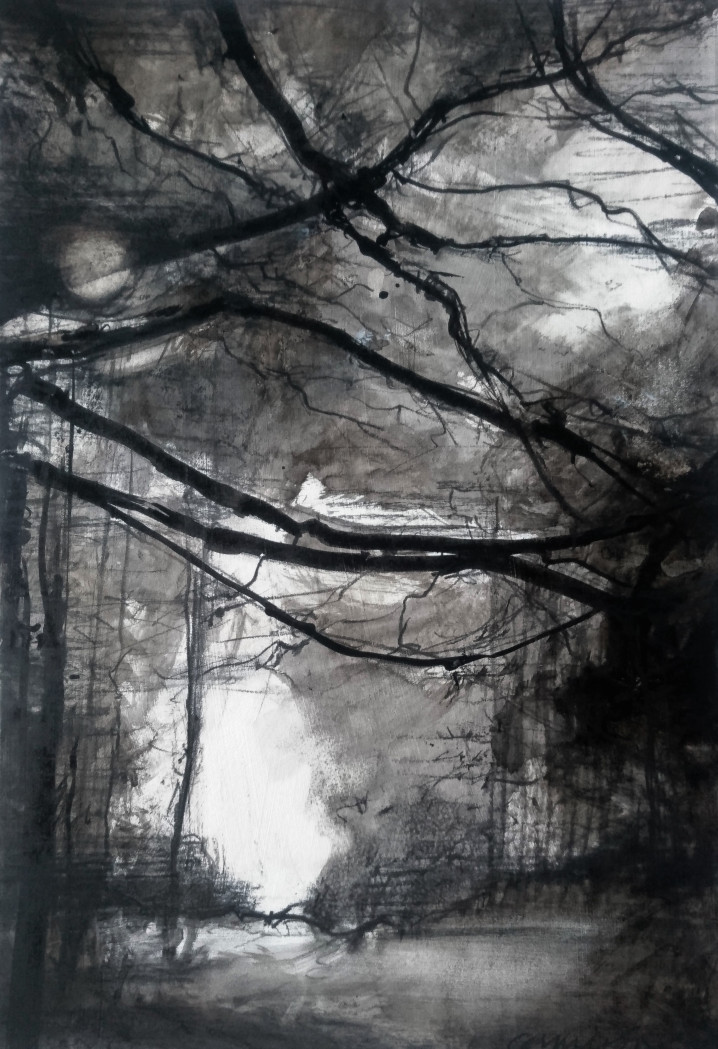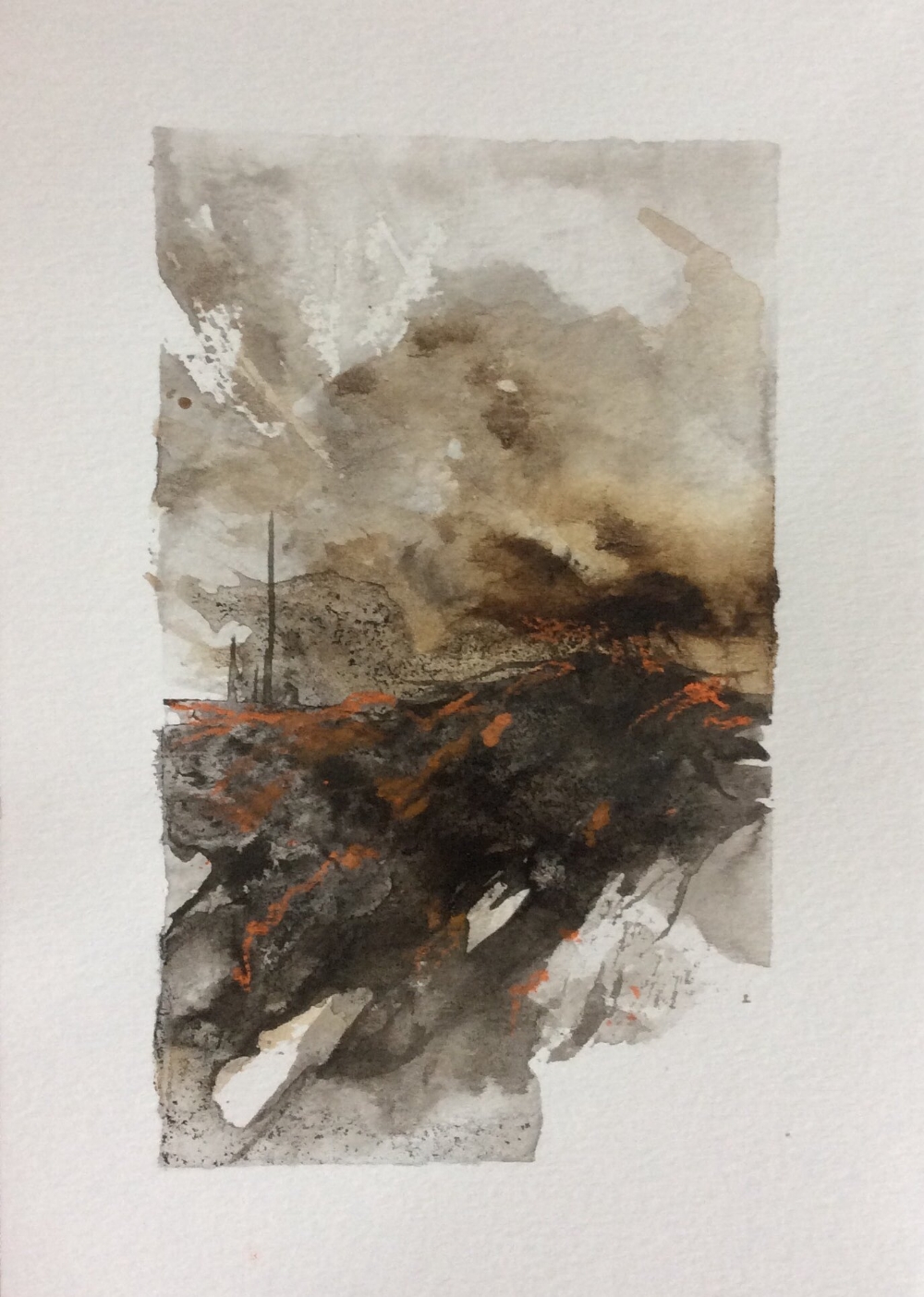I'm a curious type; I like to know what informs an artist. Who or what do they look to for inspiration? How do they work? Each month I will be asking an artist I admire a few questions, this month is Dominique Cameron.
The Wood by Dominique Cameron
Dominique, landscape is at the centre of your practice, what is it about landscape that you find so inspirational?
Landscape and walking have always played an important part in my life, from an early age I would walk the countryside with my family and my practice has developed from those earliest times. I have always had the desire to know where it is I live and having moved house many times there has always been this sense of wanting to map any new environment coupled with a curiosity of what lies beyond the door.
I'm particularly taken with the series of work that you did inspired by 'The Wood', how do you decide which type of landscape or place to focus all of your attention on for a project?
I am interested in all forms and variations of landscape, so the projects I undertake will be different each time. For instance after a project in Leith, Edinburgh I wanted to find an equivalent for the complicated, chaotic nature of urban streets. I decided on a piece of woodland not far from home which was overgrown and secluded, very visually complicated but quiet. Currently I am working on a farm which sits atop a hillside looking out over the Firth of Forth – at that point I was needing to be in the open, with far reaching views as a counter to the wood. So one project leads to another…
The Wood by Dominique Cameron
The Wood by Dominique Cameron
You use colour very vividly in some work and stick to black and white in others, is there any reasoning behind this?
My use of colour is dependent on many factors. The large woods paintings were monochrome out of a desire to see the woods pared back. I felt that I could articulate better the space by just using black and white. However it wasn’t simply black paint – there were at least four different kinds of black used. Using colour would have made the immediacy of response more difficult. However the smaller works in oil reflected the sensuousness and richness of the plant life. So in short it does depend on the subject matter.
What are the materials that you work with and is experimentation important to you?
I work with many kinds of materials from oil, acrylic, charcoal, ink, through to watercolour and gouache. I do like experimenting with their differences and at times in the studio I will often use what’s at hand, and can often be surprised by the result. I am currently interested in the juxtaposition of drawing and painting so will often use both in works, and believe there are no rules in mark making, but play is an integral part of any practice.
Leith by Dominique Cameron
Leith by Dominique Cameron
Can you outline the process of making a piece of work from start to finish?
The question of process changes with environment, materials and support. Yet the one constant is the use of gesso. I prime every surface I work on whether that be canvas, wood, panel or paper. I like the ground of gesso that gives a slight tooth and makes the support more durable. I will then go in and out of drawing and painting, building as I go until I either think its time for a cup of tea – and therefore the need to walk away. I will return to sneak up on the work, catching it by surprise almost. I immediately will know where I’ve gone wrong, what needs to be changed, and be startled by my previous decision making – it is almost as if I have not encountered the work before, it feels so new.
Tell me about your studio or creative space.
My studio is a room at one end of the house. It’s the only room that has not had any work done to it. There are doors that open out to the garden and I have a view of the sea. It’s very messy, dirty and piled high with all manner of things. Every now and then I have a clean up as I find I no longer have space. It is not very large but it’s fantastic to have the space close by. If I choose I know I can work in the middle of the night.
The Farm by Dominique Cameron
The Farm by Dominique Cameron
What artists (living or dead) inspire you?
I take inspiration from many sources, not only painters, and this list can and does change, but the artists that have remained with me would include the painters Ivon Hitchens, Joan Eardley, Cy Twombly, John Virtue and writers Virginia Woolf, Kathleen Jamie, Alice Oswald, and the filmmaker Margaret Tait.
I love learning random facts about people, tell me three things about yourself.
Three things about myself – this has proved the most difficult question. Umm…. I like to dance when I work in my studio. I used to be a fire fighter and I do like clothing with roomy pockets - for all my collections of things.
Finally, where can people follow your work online?
You can follow me on twitter - @bourbonandwolfe, and on my website – dominiquecameron.com.
Thank you to Dominique for agreeing to be part of my artist interview series. I first found Dominique on Twitter and was immediately attracted to her black and white depictions of woodland, for obvious reasons if you know me and my own work at all. I’d love a studio like hers, with doors that open on to a garden and a sea view to boot, it sounds like the absolute dream. Remember to take a look at Dominique’s website where you can find many more examples of her work on the portfolio page.
Dominique’s interview marks the end of my artist interview series, at least for now. Thank you to all of the artists that have taken part this year and to all those that have read the interviews too, I hope you have gained as much from it as I have.
If you enjoyed reading then please click the heart at the bottom, share or better still leave me a comment, I love reading them. ❤️





















